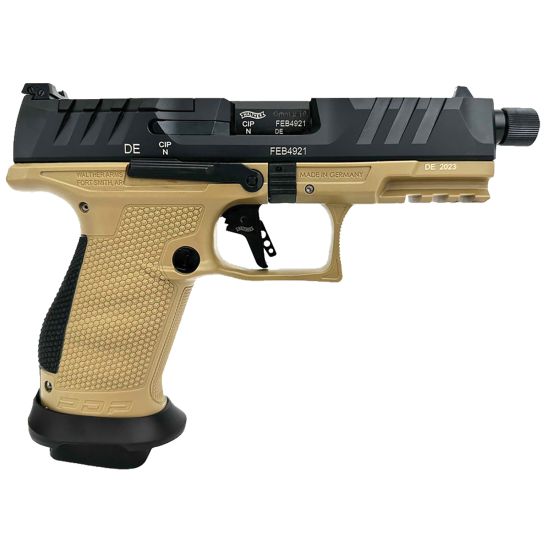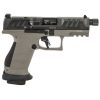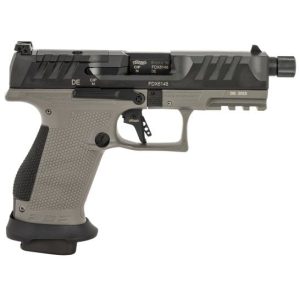Walther Arms PDP Pro Compact SD 9mm 4.60" 15rds, Flat Dark Earth – 2877520 For Sale
$799.99
The Walther Arms PDP Pro Compact SD 9mm in Flat Dark Earth, model 2877520, introduced in 2022, exemplifies Walther’s dedication to precision, innovation, and firearm excellence. This premium firearm is meticulously crafted to enhance shooting performance, featuring a 4.60″ barrel and a 15-round capacity that balances size, power, and control. The Flat Dark Earth finish offers not only a tactical aesthetic but also increased durability, while ergonomic design ensures superior grip and handling. With Walther’s signature performance-driven enhancements, the PDP Pro Compact SD provides a seamless shooting experience, appealing to both seasoned shooters and those new to firearms. Highlighting Walther’s innovative spirit, the PDP Pro Compact SD and the entire 2022 catalog promise cutting-edge craftsmanship aimed at improving precision and performance for every shooter.
What is the difference between Walther PDP and PDP Pro SD?
The Walther PDP (Performance Duty Pistol) and the Walther PDP Pro SD are both part of the same family of Walther firearms but have some distinct differences:
1. **Features:**
– **Walther PDP**: The standard PDP is designed for overall reliability and performance, featuring a duty-optimized grip texture, an adaptable grip system, and SuperTerrain serrations on the slide for easier manipulation. It is available in various dimensions and barrel lengths.
– **Walther PDP Pro SD**: The Pro SD is a more advanced version, often including enhancements for tactical or competitive use. It usually comes with upgraded features such as a threaded barrel for suppressor attachment, enhanced slide cuts for weight reduction, and possibly upgraded sights.
2. **Barrel and Suppressor Readiness:**
– **Standard PDP**: May not include a threaded barrel unless specified or customized by the user.
– **PDP Pro SD**: Specifically includes a threaded barrel designed for easy attachment of suppressors or compensators, hence the “SD” which stands for Suppressor-Ready or “Schalldämpfer” in German.
3. **Intended Use:**
– **PDP**: More oriented towards general law enforcement and civilian defensive use.
– **PDP Pro SD**: Aimed at tactical operators, shooting enthusiasts, and competitors who require tactical and customizable options.
4. **Price:**
– **PDP Pro SD** configurations are typically more expensive due to the additional features and enhancements included in the design.
Overall, the PDP Pro SD offers more tactical features and flexibility for advanced or specialized applications compared to the standard PDP model.
Is a PDP compact good for concealed carry?
The Walther PDP Compact is often considered a good option for concealed carry due to its combination of features. It offers a balance between size and capacity, with a compact frame that is easier to conceal compared to full-sized pistols. Additionally, it typically has a good grip texture, reliable performance, and is known for having a smooth trigger, all of which are important for a concealed carry firearm. However, the suitability of the PDP Compact for concealed carry also depends on personal preferences and body type, so it’s advisable to handle one or test it at a range if possible before making a decision.
Why is Walther so expensive?
Walther firearms, such as their pistols, can be expensive for several reasons:
1. **Quality and Craftsmanship**: Walther is known for producing high-quality firearms with precision engineering and durable materials. Their attention to detail and craftsmanship often result in products that are reliable and long-lasting.
2. **Innovation**: Walther has a reputation for innovation in the firearms industry, often incorporating advanced technology and design features, which can add to the cost.
3. **Brand Reputation**: Over the years, Walther has built a strong brand reputation. Buyers often trust and value the brand, which can command higher prices.
4. **Manufacturing Location**: Many Walther firearms are manufactured in Germany, where labor and production costs can be higher than in countries with lower production expenses.
5. **Specialized Features**: Some Walther models may include specialized features or designs, such as enhanced ergonomics, accuracy, or customization options, which can increase the price.
6. **Limited Production**: Some Walther models may be produced in limited quantities, making them more exclusive and, consequently, more expensive.
These factors, among others, contribute to the higher price point of Walther firearms.
What does the SD stand for in Walther PDP Pro SD?
In the Walther PDP Pro SD, “SD” stands for “Suppressor-Ready.”
What does SD stand for on a gun?
SD on a gun typically stands for “Schalldämpfer,” which is German for “silencer” or “sound suppressor.” It is often used to indicate that the firearm is equipped with a sound suppressor to reduce the noise of the gunfire.
Can the Walther PDP shoot +P ammo?
Yes, the Walther PDP is designed to handle +P ammunition, which means it can safely shoot higher pressure rounds. However, it’s always a good idea to consult the firearm’s manual or contact the manufacturer for specific guidance regarding ammunition compatibility.
Does Walther PDP take Glock mags?
No, the Walther PDP does not take Glock magazines. Each brand typically designs its firearms to be compatible with its own magazines.
Are compact pistols harder to shoot?
Compact pistols can be harder to shoot accurately compared to full-sized pistols. This is because their smaller size usually results in a shorter barrel and sight radius, which can affect accuracy. Additionally, the reduced grip size might make it more challenging to hold the pistol steadily, especially for shooters with larger hands. Compact pistols also tend to have more recoil due to their lighter weight, which can impact control and follow-up shots. However, with practice and proper technique, many shooters can become proficient with compact pistols.
Do police need a concealed carry permit?
Police officers do not typically need a concealed carry permit to carry a firearm in the line of duty. Their authority to carry firearms comes from their position and duties, rather than a civilian concealed carry permit. However, if officers wish to carry a concealed firearm while off duty, the requirements can vary by jurisdiction. Some departments may automatically extend this privilege, while others may require officers to obtain a permit, similar to civilians.
Is Walther as good as Glock?
The question of whether Walther is as good as Glock is subjective and depends on various factors such as personal preference, specific models being compared, intended use, and budget. Both Walther and Glock are reputable firearm manufacturers known for producing high-quality pistols.
– **Design and Ergonomics**: Some shooters prefer Walther pistols for their ergonomics and design features, particularly models like the Walther PPQ, which is praised for its trigger and comfortable grip. On the other hand, Glock pistols are known for their simplicity, reliability, and ease of use, which many users appreciate.
– **Reliability**: Glock has a long-standing reputation for reliability and minimal maintenance, which makes it a popular choice for law enforcement and military use. Walther also produces reliable firearms, but Glock’s track record is often highlighted in reviews.
– **Caliber and Purpose**: The choice might also depend on the specific model and caliber you’re considering, as both manufacturers offer a range of options suited for different purposes like self-defense, competition, or law enforcement.
– **Price and Availability**: Prices and availability can differ, with Glocks often being more widely available due to their popularity.
Ultimately, choosing between Walther and Glock comes down to personal preference and the individual needs of the buyer. It’s recommended to test firearms from both brands to determine which feels better in terms of handling, comfort, and performance for your specific requirements.
Is Walther still owned by Smith and Wesson?
No, Walther is not owned by Smith & Wesson. Walther was previously distributed by Smith & Wesson in the United States, but that arrangement ended in 2012. Walther is part of the PW Group, which also owns other brands like Umarex.
What Walther does John Wick use?
John Wick uses a Walther P99 in the first film of the John Wick series.
What does PP stand for in Walther?
In the context of Walther, “PP” stands for “Polizeipistole,” which is German for “Police Pistol.” This designation is used for a series of semi-automatic pistols manufactured by the German company Carl Walther GmbH.
What does PDP stand for on Walther?
PDP on Walther stands for “Performance Duty Pistol.”
What is the difference between the Walther PDP full size and compact?
The primary differences between the Walther PDP Full Size and Compact models are their dimensions and capacities:
1. **Size and Weight**:
– **PDP Full Size**: Typically has a longer barrel and overall length compared to the Compact. This makes it slightly heavier, but potentially more stable and accurate due to the increased sight radius.
– **PDP Compact**: Has a shorter barrel and overall length, which makes it lighter and more convenient for concealed carry.
2. **Magazine Capacity**:
– **PDP Full Size**: Usually comes with a higher magazine capacity due to its larger frame, commonly around 18 rounds.
– **PDP Compact**: Often has a smaller magazine capacity, commonly around 15 rounds, because of its more compact dimensions.
3. **Ergonomics**:
– Both models share similar ergonomics, with modular grip panels and texture designed for comfortable handling, but the bulkier grip of the Full Size may be preferable for those with larger hands.
4. **Intended Use**:
– **PDP Full Size**: Often chosen for home defense, target shooting, and open carry due to its size and higher capacity.
– **PDP Compact**: Preferred for concealed carry and situations where a smaller firearm is advantageous.
Both models share core features of the PDP line, such as excellent ergonomics, optics-ready slides, and advanced trigger systems, but choosing between them usually depends on the user’s intended application and personal preference for carrying size.
Be the first to review “Walther Arms PDP Pro Compact SD 9mm 4.60" 15rds, Flat Dark Earth – 2877520” Cancel reply
Related products
Walther Arms PDP Pro Compact SD
Walther Arms PDP Pro Compact SD 9mm 4.60" 15rds, Tungsten Gray – 2876574



Reviews
There are no reviews yet.